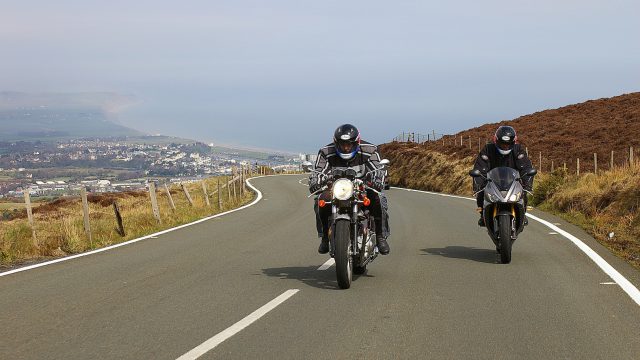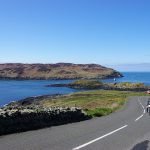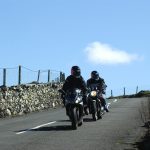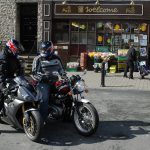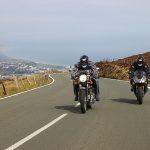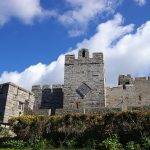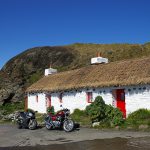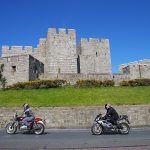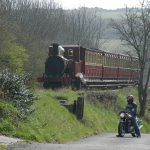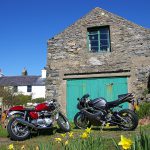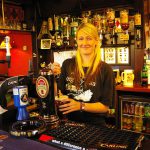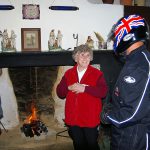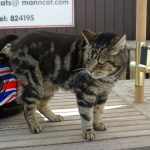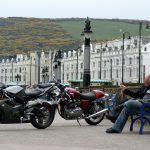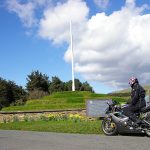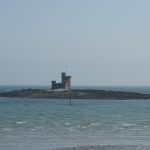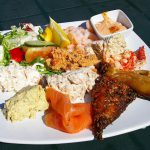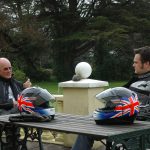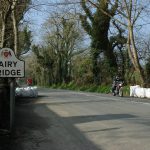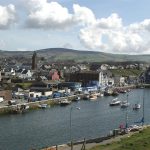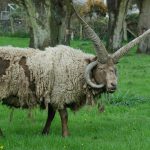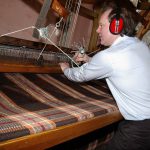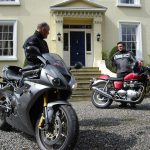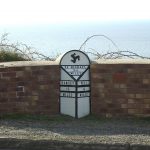Father and son exploring the Island on two Triumphs, a 675 Daytona and a Bonneville
One hundred and ten years ago in 1907, the first Tourist Trophy race was held on the Isle of Man – a small, oval-shaped island lying between Great Britain and Ireland, measuring 32 miles long and 15 miles across. Laced with austere moorlands, wooded glens, sandy beaches, lonely castles and time-warp towns, the Island is the home of the oldest and most famous race circuit in the world, the Snaefell Mountain Course, to give it its proper name.
Although it’s possible to see what Manx people insist is a total of six kingdoms – Wales, England, Scotland, Ireland, Ellan Vannin, and Heaven! – from the slopes of Snaefell, at 2,036 ft./621 metres above the Irish Sea the Island’s highest point, the Isle of Man (Ellan Vannin in the local Manx language) is not part of the United Kingdom, but a Crown dependency whose original Viking settlement was ceded to Scotland by the King of Norway in 1266. Today, the Queen of England is also the Lord of Mann, represented on the Island by a Lieutenant Governor, complete with all the trimmings of a quasi-colonial setup. As a diehard motorcyclist, Her Majesty’s eldest grandson Prince William was an anonymous visitor to the TT Races in 2003, the year that Triumph crowned its return to the Island with Kiwi Bruce Anstey’s victory in the Supersport TT on a 600 Daytona four that ‘Wills’ himself later rode at a private test at Goodwood. Queen Elizabeth’s face graces Manx banknotes, but they aren’t legal tender anywhere beyond the Island. The Island is not part of the EU. It is, however, a flourishing offshore financial center which has seen many “come-over” residents—including MotoGP racer Cal Crutchlow, former World Superbike Champion James Toseland and his World Supersport counterpart, Aussie Andrew Pitt—taking advantage of the low, 18 per cent income-tax ceiling. But the Island’s population of 85,000 people – 28,000 of them in Douglas, its capital and ferry gateway – doubles for the two weeks of the Tourist Trophy races.
All the more reason, then, to get away from the crowded, 37.73-mile Mountain Course and explore the other parts of this pocketbook-sized country, which packs a huge amount of variety and history into its 221 square miles. As a former TT rider with an honourable but unexceptional, yet fortunate IoM race record – I finished fourth once, fifth once, eighth and ninth, but twice crashed at places where others have died – I’ve always enjoyed my two dozen trips across the Irish Sea to Mona’s Isle, a third, more romantic title for the island. That’s even though, as one of the host of self-funded privateers making up the bulk of the TT entry, I too often spent most of Practice week locked up in a borrowed garage preparing my racebike(s), when not actually out riding round the Course either in an official timed session, or else on a road bike to brush up on my course knowledge. But, depending on how many different rides you had, race week was paradoxically more relaxed, and especially on Mad Sunday when since like most other racers I made it a point of principle never to set a wheel on the TT Course, there was the chance to explore other parts of the Island, aided nowadays by the informative IoM government website www.isleofman.com
I’d never, however, taken my bike-mad eldest son Andrew with me – an omission rectified by taking a pair of Triumphs on a three-day trip there. Our adventure was blessed with uninterrupted springtime sunshine— although its position in the Irish Sea scooping up the remnants of the Gulf Stream sees Florida-style palm trees scattered in gardens along its coast, the Isle of Man doesn’t so much have a climate as constantly changeable weather. In Manx mythology, the Island was ruled by a Celtic sea god named Manannan mac Lir, after whom the Isle of Man is named. Legend has it he drew his misty cloak around the Island to protect it from invaders. I used to curse him as I groped my way up the Mountain Mile in a fog-shrouded, early-morning practice session, but he’d obviously decided I was friend, not foe, this time around. The Island’s terrain includes many narrow, twisting, hilly lanes where the twin-cylinder torque of Andrew's Bonneville came into its own, as well as the stretches of road where my 675cc Daytona triple could stretch its legs. Apart from strict restrictions in towns and villages, there’s still no overall speed limit on the Island. “Derestricted” means exactly that.
“There are a few places in the world that have managed to slip through a crack in the space-time continuum, or fallen off the back of the history lorry to lie amnesiac in the road to progress. And the Isle of Man is caught permanently in the pork-pie jelly of 1957.” So wrote the late British humorist A.A.Gill after visiting the Island – and know what, he’s right. Though there are many stone farmhouses and fisherman’s cottages, the most potent reminder of the way the island used to be is the Cregneash National Folk Museum in the far south near Spanish Head (so named because it acted as a lookout point for the Spanish Armada). Dozens of houses and large stretches of the surrounding countryside create an authentic picture of traditional rural life, complete with regular demonstrations of making yarn with a spinning wheel, milking cattle, cheese-making, dying wool, blacksmithing, shoeing horses, thatching roofs and so on.
The rare, four-horned Logthan sheep and Manx-bred working horses are native to the island, as is the unique tailless Manx cat. Highly intelligent, with a dense double coat of fur, and more solidly built with longer hind legs than a normal household pussy, a Manx cat is the result of spontaneous mutation, rather than the legend which insists it was all Noah’s fault, after the rains began while he was still filling the Ark, and he caught the tail of one of the cats coming aboard in a door when he hurriedly closed it to keep the water out. There are three kinds – a completely tailless ‘rumpy’, a ‘stumpy’ with a vestigial one, and a normal-style ‘tailie’. Having had one of each, our family can confirm that Manx cats make marvellous pets, being very affectionate with lots of personality, one reason they’re often referred to as the ‘Dog Cat’. Andrew wasn’t so sure any dog would have climbed onto his shoulders to lick his cheek, like one of them did, though…
South from the airport Castletown lies on the site of an ancient volcano. It’s the island’s most scenic and historic town, for many centuries the capital before the government moved to Douglas in 1866. Dominated by the medieval Castle Rushen, Castletown traces its origins back to 1090 A.D., making it one of the oldest towns in the British Isles. It’s still an active port, too, as well as playing host to the annual Southern 100 motorcycle races held each July round the 4.25-mile Billown circuit on the outskirts of town.
The Isle of Man’s yachting capital, Port St. Mary, and sandy-beached Port Erin, are the two most southerly towns, each retaining some vestige of their days as Victorian seaside resorts. They act as the gateway to Cregneash, and beyond it the Calf of Man, a small, uninhabited bird sanctuary islet off the southern tip. A magnificent stretch of rocky coastline provides arguably the island’s most glorious bike ride, past slate cliffs rising steeply from the sea lined in summer with bright-yellow gorse and bracken. Southwards, Cronk ny Irrey Lhaa with its wild moorlands rises steeply from sea level to its 1500-foot summit; its name means “Hill of the Break of Day,” so called because fishermen returning to Peel after a night at sea looked for the sunrise over it.
Peel is an historic working port, with its own ancient castle and ruined 13th-century Cathedral on St. Patrick’s Isle lying just offshore, linked to the mainland via a causeway and reputed to be haunted by Moddey Dhoo, a ghostly black dog. Here the first Christian missionaries arrived from Ireland in the middle of the fifth century, an influx recalled by the many Manx Crosses dotted around the Island. There are also many fine stone circles and monuments up to 5000 years old found throughout the Island, some of which, like Stonehenge, date back to Neolithic times. The oldest man-made construction in the Isle of Man is the four-tiered mound of earth known as Tynwald Hill, inland from Peel. This may have originally started off as a burial mound, but was adopted by the Vikings more than 1000 years ago for matters of government. It is celebrated as the site of the oldest continuous parliament in the world in 979 AD—although today’s Manx parliament, still known as the Tynwald, sits in Douglas.
St. John’s Church was the venue for the very first Isle of Man TT motorcycle race, held in 1907 over a loose-surfaced, 15¾-mile course. Starting there, it ran to Ballacraine, then joined the current TT course as far north as Kirkmichael, before turning left and following the coast down to Peel, then swinging inland to St. John’s again. Retracing this original circuit also gives fine views out over the sea past the occasional basking whale on the run down the west coast to Peel—an ideal place to sit out in the sunshine by the busy harbor enjoying a plate of locally caught seafood with a glass of Castletown Ale. Fish and seafood—especially crab, Manx lobster and queenies, a sweet-tasting small scallop that is the local speciality—are succulent and fresh almost no matter where you try them, and the many Manx pubs are a great place to sample the local drink. Try the Shore Hotel in Laxey for the silky brew with a nutty flavor of the Old Laxey Brewery, one of the several small boutique breweries now springing up on Mona’s Isle. Right next door is the Mona Lisa, one of several authentic Italian restaurants on the Island, a legacy of its role during both World Wars when Douglas and other towns were home to internment camps for “enemy aliens.” A section of the Promenade was in fact cordoned off, with many guest houses used for this purpose.
With its sandy beach, breakwater and busy harbor, Peel was a hotbed of smuggling in the 18th century. Today, a fleet of fishing boats make it the center of the Island’s fishing industry. The EU quota system has seen the export of herring much reduced in recent years, but there are still enough to supply the smokeries, which produce the Isle of Man’s most famous fish speciality, the Manx kipper. In the 19th century women would hand-work the herring, but now a specially designed machine is used to smoke the fish over oak chips. The process turns the fish red, thus transforming it into a “red herring.”
Andrew and I stayed at The River House B&B in Ramsey, a lovely Georgian country house lying beside a river on the outskirts of the Isle of Man’s northernmost town. We reached Ramsey by following the TT course as far as Sulby, then turning inland for a beautiful ride along Sulby Glen before following the course of the old Tholt-y-Will hillclimb up the Mountain to the foot of Snaefell. We then rejoined the TT course again Just below the Bungalow to take the scenic route down to Ramsey, with great views of its wide sandy beach from Guthrie’s on down to the Gooseneck.
After that brief taste of the TT course, we went along the coast road running through the soft, leafy Maughold Peninsula before passing through acres of strong-scented wild garlic to Laxey, a strung-out mining town on the east coast. Down below it, on the way to the shingle beach, are the Laxey Woollen Mills where Manx tartan and tweed are woven on traditional looms.
If we hadn’t had the bikes, we might have ridden down to Douglas on the Manx Electric Railway, a 17-mile-long line offering year-round service, which opened in 1893. Two of the original three cars which inaugurated the line that year are still in service today, and are the oldest electric tramcars still at work on their original line anywhere in the world.
Douglas is where most come-over visitors end up staying. The broad sweep of Douglas Bay, lined by its wide, newly repaved Promenade, makes for a nice stroll. You can walk along the seafront in one direction, then catch a horse-drawn tram back again. Out in the bay, the small Tower of Refuge castle was built on Conister Rock as a sanctuary for shipwrecked sailors. The Gaiety Theatre on the Prom is an authentic, functioning example of a Victorian music hall dating from 1900. Many of the buildings on the Prom used to be B&Bs and boarding houses, but it’s a mark of the Island’s move upmarket that many of them now have been turned into apartments. Time moves on—and even the Isle of Man moves with it.
It may look like Britain, but the Isle of Man is delightfully unique. Quaint and quirky, the Crown dependency has its own parliament, language, currency and culture, as a haven of Celtic history, Manx cats, ruined castles and a retro lifestyle. No wonder so many diehards are in the habit of going there every year. There’s nowhere else quite like it anywhere in the world – and with the added bonus of the world’s toughest race, this year celebrating its 110th birthday, it’s hard to resist.
* * * * *
Photo credit: Kyoichi Nakamura
